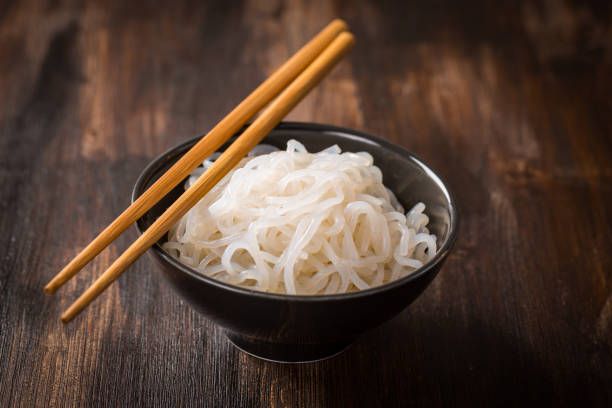Shirataki Noodles: The Ultimate Healthy Low Carb Pasta Alternative
Shirataki noodles are a good source of dietary fiber, which can help to regulate digestion and promote bowel health. They are also low in calories and carbohydrate, making them a suitable choice for people on a weight loss or diabetic diet...

Shirataki noodles are a popular low-carbohydrate pasta alternative. They come from Japan, where they are made from the konjac plant, which is a yam-like vegetable. Konjac root is high in fiber and glucomannan, a soluble dietary fiber making shirataki noodles a healthy and filling option.. When shirataki noodles are cooked, they take on a sticky and chewy texture.
Page Contents
Shirataki noodles are a good source of dietary fiber, which can help to regulate digestion and promote bowel health. They are also low in calories and carbohydrate, making them a suitable choice for people on a weight loss or diabetic diet. Additionally, shirataki noodles are low in fat and contain no cholesterol. They are both gluten-free and vegan-friendly, making them a good choice for people with dietary restrictions.
The Benefits of Eating Shirataki Noodles
- Shirataki noodles are low in calories and carbohydrates: One cup of shirataki noodles contains only 20 calories and 5 grams of carbohydrates, making them a good choice for people on a diet.
- Shirataki noodles are a good source of fiber: Shirataki noodles are a good source of dietary fiber, which can help to regulate digestion and prevent constipation.
- Shirataki noodles may help to reduce blood sugar levels: Studies have shown that shirataki noodles may help to reduce blood sugar levels in people with diabetes.
- Shirataki noodles are gluten-free: Shirataki noodles are gluten-free, making them a good choice for people who are allergic to gluten.
- Shirataki noodles are a healthy alternative to traditional pasta, which is high in calories and carbohydrates.
Are Shirataki Noodles Healthy?
Shirataki noodles are a type of Japanese noodle that is made from the konjac yam. They are also known as konjac noodles or konnyaku noodles. Shirataki noodles are very low in calories and carbohydrates, and they are a good source of dietary fiber.
One cup of shirataki noodles contains only 20 calories and 5 grams of carbohydrates, making them a good choice for people on a diet. Shirataki noodles are also a good source of dietary fiber, which can help to regulate digestion and prevent constipation. Additionally, shirataki noodles are gluten-free, making them a good choice for people who are allergic to gluten.
Shirataki noodles are a healthy alternative to traditional pasta, which is high in calories and carbohydrates. One cup of shirataki noodles contains only 20 calories and 5 grams of carbohydrates, while one cup of cooked spaghetti contains 221 calories and 43 grams of carbohydrates.
How to Cook Shirataki Noodles
Shirataki noodles can be cooked in a variety of ways. They can be boiled, stir-fried, or used in soups or salads. When cooking shirataki noodles, it is important to rinse them well under cold running water to remove any excess starch. This will help to give them a more authentic ramen noodle texture.
- Pour shirataki noodles into a colander and rinse with cold water.
- Shake off the excess water and place the noodles in a saucepan.
- Add enough boiling water to cover the noodles, and let them cook for 2-3 minutes.
- Drain the noodles and rinse with cold water again.
- Serve shirataki noodles with your favourite sauce or dish.
Some Shirataki Noodle Recipes
1. Shirataki Noodles with Spicy Peanut Sauce
Ingredients:
- 1 package shirataki noodles
- 2 tablespoons peanut butter
- 2 tablespoons soy sauce
- 1 tablespoon honey
- 1 teaspoon sriracha sauce
- 1 clove garlic, minced
- ¼ cup water
Instructions:
- In a small bowl, whisk together peanut butter, soy sauce, honey, sriracha sauce, and garlic.
- Pour the sauce into a skillet and heat over medium-high heat.
- Add shirataki noodles and cook for 2-3 minutes, until heated through.
- Serve with desired toppings.
2. Shirataki Noodles With Sesame Ginger Sauce
Ingredients:
- 1 package shirataki noodles
- 2 tablespoons tahini
- 1 tablespoon soy sauce
- 1 tablespoon rice vinegar
- 1 teaspoon honey
- ½ teaspoon ground ginger
- 1 clove garlic, minced
- ¼ cup water
Instructions:
- In a small bowl, whisk together tahini, soy sauce, rice vinegar, honey, ginger, and garlic.
- Pour the sauce into a skillet and heat over medium-high heat.
- Add shirataki noodles and cook for 2-3 minutes, until heated through.
- Serve with desired toppings.
3. Shirataki Noodles with Tomato Basil Sauce
Ingredients:
- 1 package shirataki noodles
- 1 tablespoon olive oil
- 1 clove garlic, minced
- ½ cup diced tomatoes
- ¼ cup chopped basil leaves
- salt and pepper to taste
Instructions:
- In a skillet, heat olive oil over medium heat.
- Add garlic and cook for 1 minute.
- Add diced tomatoes and cook for 2-3 minutes, until heated through.
- Stir in shirataki noodles and basil leaves. Season with salt and pepper to taste.
- Cook for 2-3 minutes, until shirataki noodles are heated through.
- Serve with desired toppings.
Shirataki Noodle Substitutes
- Spaghetti squash: Spaghetti squash is a low-carbohydrate alternative to shirataki noodles. One cup of spaghetti squash contains only 40 calories and 10 grams of carbohydrates.
- Zucchini noodles: Zucchini noodles are a healthy alternative to shirataki noodles. They are made from zucchinis, a type of squash, and are high in fiber and other nutrients. One cup of zucchini noodles contains only 30 calories and 7 grams of carbohydrates.
- Cauliflower rice: Cauliflower rice is a low-carbohydrate alternative to shirataki noodles. One cup of cauliflower rice contains only 25 calories and 5 grams of carbohydrates.
- Kelp noodles: Kelp noodles are a low-carbohydrate alternative to shirataki noodles. They are made from kelp, a type of seaweed, and are high in iodine and other nutrients. One cup of kelp noodles contains only 20 calories and 4 grams of carbohydrates.
- Bean sprouts: Bean sprouts are a low-carbohydrate alternative to shirataki noodles. They are made from mung beans and are gluten-free. One cup of bean sprouts contains only 15 calories and 2 grams of carbohydrates.
- Lettuce: Lettuce is a low-carbohydrate alternative to shirataki noodles. It is high in fiber and other nutrients. One cup of lettuce contains only 5 calories and 1 gram of carbohydrates.
- Celery: Celery is a low-carbohydrate alternative to shirataki noodles. It is high in fiber and other nutrients. One cup of celery contains only 25 calories and 2 grams of carbohydrates.
- Cabbage noodles: Cabbage noodles are a healthy alternative to shirataki noodles. They are made from cabbage, a type of cruciferous vegetable, and are high in fiber and other nutrients. One cup of cabbage noodles contains only 25 calories and 5 grams of carbohydrates.
- Carrot noodles: Carrot noodles are a healthy alternative to shirataki noodles. They are made from carrots, a type of root vegetable, and are high in fiber and other nutrients. One cup of carrot noodles contains only 30 calories and 7 grams of carbohydrates.
- Spaghetti squash: Spaghetti squash is a healthy alternative to shirataki noodles. They are made from spaghetti squash, a type of winter squash, and are high in fiber and other nutrients. One cup of spaghetti squash contains only 40 calories and 10 grams of carbohydrates.
- Butternut squash noodles: Butternut squash noodles are a healthy alternative to shirataki noodles. They are made from butternut squash, a type of winter squash, and are high in fiber and other nutrients. One cup of butternut squash noodles contains only 50 calories and 12 grams of carbohydrates.
- Spiralized vegetables: Spiralized vegetables are a healthy alternative to shirataki noodles. They are made from vegetables, such as zucchini, cucumber, and sweet potato, that have been spiralized into noodle-like shapes. Spiralized vegetables are a good source of dietary fiber and other nutrients.
When substituting shirataki noodles for another type of noodle, it is important to consider the calorie and carbohydrate content of the substitute. Some substitutes, such as spaghetti squash, zucchini noodles, and bean thread noodles, are lower in calories and carbohydrates than shirataki noodles. Other substitutes, such as kelp noodles, rice noodles, and spiralized vegetables, are higher in nutrients but also higher in calories and carbohydrates.
Some Tips on How to Make The Most of Your Shirataki Noodle Experience
When cooking shirataki noodles, it is important to rinse them thoroughly before cooking. This will help to remove the slight fishy odor that they have. Shirataki noodles can be cooked in several ways, including boiling, microwaving, and stir-frying.
Here are a few tips for making the most of your shirataki noodle experience:
- Rinse the noodles thoroughly before cooking to remove any fishy odor.
- Cook the noodles in a variety of ways, including boiling, microwaving, and stir-frying.
- Add shirataki noodles to soups, stews, or other dishes for a filling and nutritious meal.
- Enjoy shirataki noodles as a healthy and low-carbohydrate alternative to traditional pasta.
Varieties Of Shirataki Noodles
Some versions of shirataki noodles contain mixtures of shirataki flour and tofu allowing noodles to be less rubbery than usual. The tofu version of shirataki noodles have a white-orange opaque colour similar to those of rice noodles.
Tofu shirataki noodles can be ordered as standard shapes, including macaroni, pasta, fettuccine or angel hair. Like regular Shirataki, these products can be eaten immediately but you'll have the choice between putting them in boiling water in a microwave and frying them in boiling water.
Shirataki vs. Glass noodles
Shirataki noodles have the same characteristics as glass noodles which refer to a variety of glutenless noodles based on different starches like potato starches, mung bean starches and tapioca.
They are used for many different dishes including stirfries, stews, salads and many other dishes. Unlike shirataki noodles, glass noodles can be sold dry or cooked for softening. After cooking their springiness has a similar feel with a similar texture as shirataki rice.

